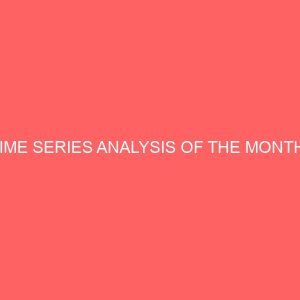Description
ABSTRACT
It is widely accepted that water supply will be a pressing issue in this century. Thus, position of adequate rainfall in the development of human and natural resources is a worthwhile research work. The data used in this project work was monthly amount of rainfall in Enugu city within the period of 2000 2012.A preliminary inspection on the data revealed that the data has no trend but consist of multiplicative seasonal movements. Furthermore, the monthly data was also found to be stationary and serially uncorrelated by the Augmented Dickey Fuller test of unit root and the Autocorrelation test for serial correlation of the error term respectively.
The exponential smoothing procedures were adopted for the construction of the best fit model for the prediction of future rainfall pattern in Enugu. This was achieved by algorithms aimed at smoothing out all irregular components inherent in the series. The best fit model parameters were used to predict monthly rainfall distribution for 2013. The result suggested heavy rainfall in general for the year in question with its amplitude in the month of October.
CHAPTER ONE
General Introduction
Water resources are essential renewable resources that are the basis for existence and development of a society. Proper utilization of these resources requires assessment and management of the quantity and quality of the water resources both partially and temporally. Water crises cause by shortages, floods and diminishing water quality, among other, are increasing in all parts of the world. The growth of population demands for increased domestic water supplies and are the same time, results with a higher consumption of water due to expansion in agriculture and industry. Mismanagement and lack of knowledge about existing water resources and the changing climatic conditions have consequences of an imbalance of supply and demand of water. The problem is pronounced in semiarid and arid areas where the resources are limited.
Surface water being easy, direct and therefore less expensive to exploit in compassion to other sources like ground water or desalination makes it the major source of water supply for irrigation, industry and domestic uses. The surface water, in form of lakes and river discharge runoff is predoming obtained from rainfall after being generated by the rainfall runoff processes.
The primary source of water agricultural production for most of the world is rainfall. Three main characteristics of rainfall are its amount, frequency and intensity, the value of which way from place to place, day to day, month to month and also year to year. Precise knowledge of these three main characteristics is essential for planning its full utilization.
Information of the amount, intensity and distribution of monthly or annually rainfall for the most important places in the world is generally available. Long term records of daily rainfall have been compiled for years, norm and standard deviations have been worked out, floods and droughts have been defined and climate zones of potential evaporation less precipitation have been mapped from rainfall pattern and crop studies. Investigation using electronic computer are continuous in progress and effective are being made to predict future trend in order for refine planning.
Most rain water is used in agriculture for crop production. Therefore, the first point which arises is whether the available rainfall adequate and well distributed for crop raining. This new water rate structure encourages water conservation. Preliminary calculations done by city staff confirmed the advantages of the new billing system. However, a specific water forecast model is required for a more precise estimation of the influence of the new rate structure on water consumption and on revenue collection. Such a model will allow testing of different rate structures and different conditions affecting water use and therefore revenue water price, conservation programs, and weather conditions.
The water forecasting system is very powerful decision support tool. The precise estimation of the future water consumption is essential for determining the water management policy including the efficient water use and for the water purchase planning. The revenue projections are necessary for budget preparation. The knowledge of the future water production is indispensable for utility planning and management.
1.1 Method of Measuring Rainfall
Rainfall is usually measured by first collecting it in a rain gauge. These special drums are then used to record the depth of the water inside. Rain gauge is 5 usually about 50 cm tall and is place on the ground just high enough to avoid splashes. Rain water that is caught in a funnel on top runs down into a measuring cylinder below where it can be recorded.
1.2 Method of Data Collection
The information Data collected for the analysis of this project work is purely secondary data that is, already made data. The data on the monthly amount of rainfall 20002012, were collected from Nigeria Meteorological Agency Enugu state. The data are recorded on daily basis so that at the end of each month the overall total will be calculated.
1.3 Objectives of the Study
Having known that rainfall is important in the development of the nation and nations wealth. This research work Conduct a preliminary check on the data obtained to gain sight on the on the pattern of trend and seasonal components that constitutes monthly amount of rainfall in Enugu City during the period covered.
To investigate whether the sample obtained comes from the normal population.
To conduct the unit root test on the data obtained using the Autocorrelation test, ACF at lag k, and the Augmented Dickey Fuller test.
To determine the seasonal adjustment factor using the twelve 12 point multiplicative moving average approach.
To establish the best fit model for the observations using the exponential smoothing method.
To forecast monthly amount of rainfall in Enugu using the best fit model parametres for the year 2013.
To make recommendation based on our findings.
1.4 Scope of the Study
This project work/research is restricted to Nigeria Meteorological Agency in Enugu State. The study covers a period of twelve 12 years 20002012. It takes into consideration of the monthly amount of rainfall in Enugu City.
1.5 Statement of the Problem
The researcher has the interest in knowing about the problems of rainfall in Enugu city. The objective is to provide answers to:
Does climatic change affects the monthly amount of rainfall
Has there been any significant difference in the monthly amount of rainfall from 20002012.
Does the trend of monthly amount of rainfall decrease yearly from 20002012
Does seasonal variations affects the monthly amount of rainfall in Enugu city.








Reviews
There are no reviews yet.